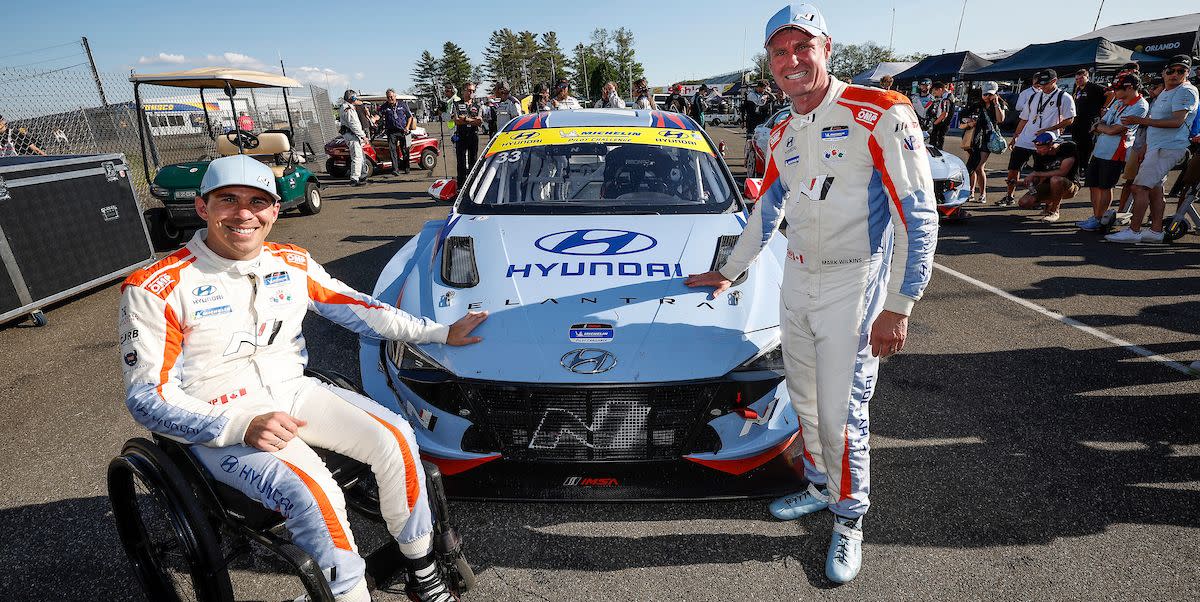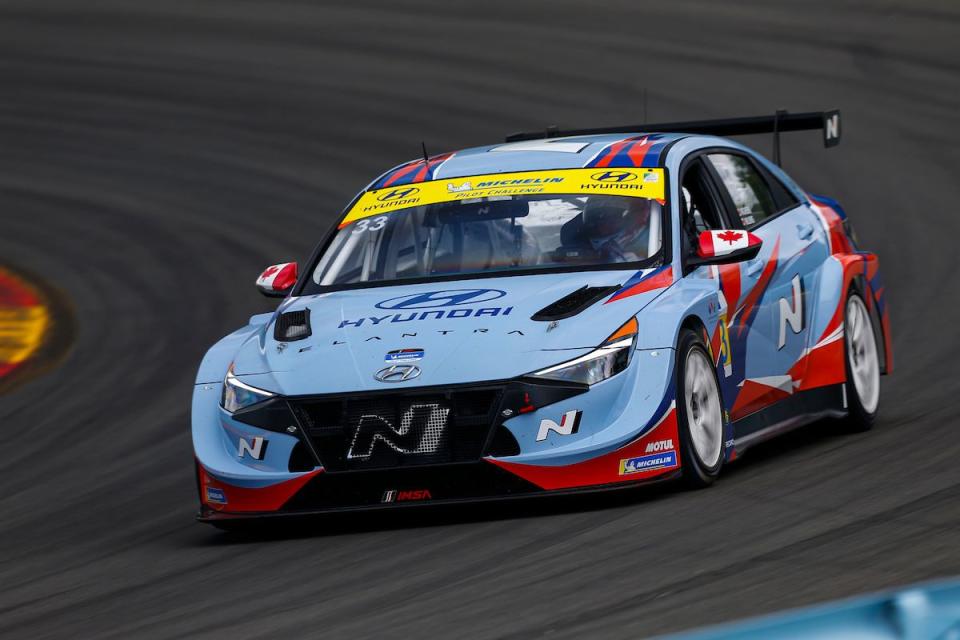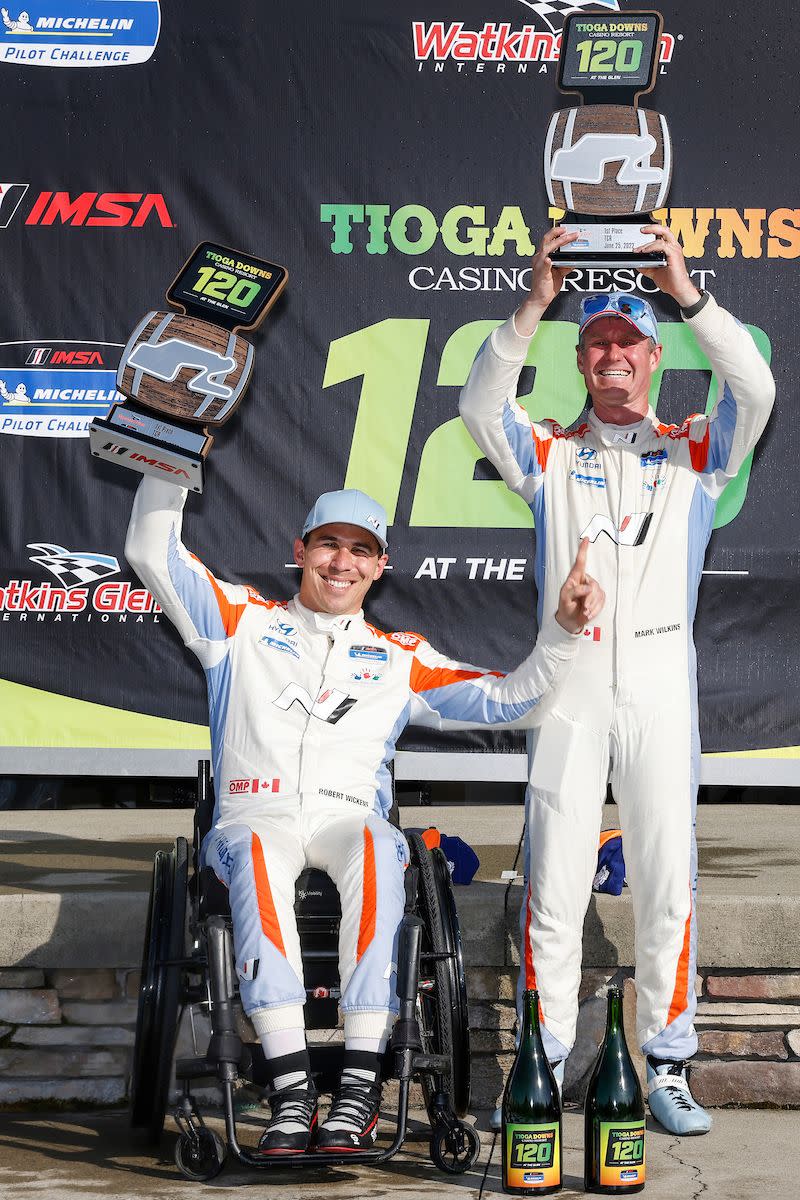How Paralyzed Racer Robert Wickens Deals with New Speed Limits in Comeback

- Oops!Something went wrong.Please try again later.
- Oops!Something went wrong.Please try again later.
- Oops!Something went wrong.Please try again later.
Using special hand controls, Wickens has been able to return to racing in the IMSA Michelin Pilot Challenge this year.
Former IndyCar racer Sam Schmidt and motorcyle drag racer Wayne Rainey was also back in racing machines this past weekend at Goodwood.
After finishing third as a co-driver with fellow Canadian Mark Wilkins in his first race since his injury in the season-opening event at Daytona back in January, Wickens returned to victory lane for the first time since 2017.
This past weekend was a milestone for several former drivers who had their racing careers cut short due to devastating crashes that dramatically changed their lives.
Yet despite injuries that left them all paralyzed, they’ve never lost their need for speed—and they all showed this past weekend how accessible driving technology and other driving-assist elements not only helped them get back in the game, but also give hope for other racers who have suffered life-changing injuries.

At the annual Goodwood Festival of Speed in England, Arrow McLaren SP IndyCar team co-owner Sam Schmidt completed the signature hill climb in a special McLaren 720S Spider that was modified by primary team sponsor Arrow Electronics.
Schmidt, who previously drove a specially-prepared Corvette at Goodwood in 2014, used new technology that allowed him to control acceleration and braking through a straw-like “sip and puff” device, while also utilizing head movements and his breathing to steer the car, according to Engadget.com.
Schmidt was left a quadriplegic in 2000 when he crashed during a practice session at the former Walt Disney World Speedway near Orlando, Florida.
Also at Goodwood, three-time world champion motorcycle racer Wayne Rainey, who was paralyzed from the chest down after crashing in a race in 1993, climbed aboard the same bike he won his last title in 1992. The bike had been on display at the Yamaha Museum in Japan for the past three decades.
But special modifications, including adding bicycle-like training wheels to keep the bike upright, as well as relocating controls for the shifter as well as the rear brake to the handlebars, allowed Rainey to ride the bike once again using only his hands.

It was an emotional time for Rainey, who was joined by former chief rival Kenny Roberts—now one of Rainey’s closest friends—as well as Rainey’s son Rex, who helped his father get on and off the bike. Rex Rainey was just 10 months old when his father was injured.
As Rainey said, “I guess dreams do come true.”
And then there was Robert Wickens, who was paralyzed in an IndyCar race at Pocono Raceway in 2018.
Using special hand controls, Wickens has been able to return to racing in the IMSA Michelin Pilot Challenge this year. After finishing third as a co-driver with fellow Canadian Mark Wilkins in his first race since his injury in the season-opening event at Daytona back in January, Wickens returned to victory lane for the first time since 2017 this past weekend at Watkins Glen International.
“It was a great weekend for disability awareness,” Wickens said of his achievement as well as those of Schmidt and Rainey on a Tuesday IMSA teleconference.
Even though his return to IndyCar racing is unlikely—unless technology can be developed to allow him to do so under IndyCar rules—Wickens remains part of the Arrow McLaren SP team that Schmidt co-owns as an ambassador of sorts.

“Sam Schmidt driving his McLaren 720 up the hill at Goodwood, I think he broke his previous record from last year when he did it in the Corvette,” Wickens said. “It's just pretty cool. And to get a win at Watkins Glen in the Michelin Pilot Challenge for me personally was just incredible.”
While Wickens is thankful for the technology that allows him to co-drive the No. 33 Bryan Herta Autosport with Curb/Agajanian Hyundai Elantra N-TCR, he’s also been part of the development of even more technology that is encouraging for other drivers who have suffered catastrophic injuries while racing.
“But there's always things holding you back,” Wickens said. “Even right now with what we've been able to achieve so far this season in the Michelin Pilot Challenge, I feel like I'm getting more and more comfortable every weekend with my hand controls, but we're also exposing areas where the hand controls could be evolved and improved.
“Now we're in the middle of the summer swing with back-to-back races this weekend at Canadian Tire Motorsports Park, then one weekend off before we go to Lime Rock Park in the middle of July, and there's no real opportunity to get some testing in and to actually show proof of concept of the updated system or something to improve without guaranteeing reliability.
“We’re not going to go straight into a race weekend with an updated system not fully understanding if it will work reliably or not. So, I think we're at the point right now where we've definitely met the capacity of my hand control system. Thankfully, it's reliable, it's competitive, I have good feeling with it and I'm still getting more and more comfortable with it, which is why I think more performance is coming in each race.
“But each category sees its own complications. If you look into a faster car with more downforce, it also requires more braking force, which then requires more pneumatic assistance for me to achieve the same brake pressure as an able-bodied driver. With the TCR car, the Hyundai Elantra, you have to apply the brake very hard. To put it into simple terms, like for me to match the brake pressure that Mark Wilkins can achieve, I'm having to pull the brake ring with roughly around 100 pounds of force.
“So imagine, everyone has done those grip test things at some point in their life, imagine squeezing 100 pounds and I get to do that 11 corners at Watkins Glen and I’ll do it for 10 corners at Canadian Tire Motorsports Park this weekend. It's no easy task and moving forward in other categories (classes and types of racing like IndyCar), there's always different demands. I think it's an open book. There's no real known quantities on where the complications might lie and sometimes you just find after experiencing it.”
Even though Wickens, who along with wife Karli are expecting their first child in mid-July, has had to get used to totally different technology to compete behind the wheel, yet some things are the same, kind of
“It's like riding a bike, but it's a very different bike, I guess is the best way to describe it,” Wickens said. “Racing has been my life since I was seven years old. It's something I worked very hard to get to the level I was at when I was racing in IndyCar in 2018. And after the accident, I just knew I had to work harder to try get back to that.

“I didn't know what it would look like for me. I didn't know if I could return straight into IndyCar or if I would have to start off in go-karts, like you do as a kid. The whole recovery just was a bit of an unknown. Luckily, we landed somewhere in the middle with the kind folks at Hyundai and Bryan Herta giving me the chance to race in the Michelin Pilot Challenge.
“It just feels great. I've always been my happiest when I'm behind the wheel of a race car. It doesn't matter if it's a stressful race with a lot of PR and a lot of press around it. The second you put your helmet on and close that door, it's just peace for me and I can finally just get into the zone and get into the race and it's been my happy place for most of my life. Yeah, it feels great to get back there. … Yeah, life’s great, it almost feels like you're living in a dream sometimes.”
Wickens does not see a return to IndyCar at this point in his career.
“It's challenging,” Wickens said. “What Bryan Herta Autosport and Hyundai were able to achieve from an ingenuity standpoint of getting the hand control system installed into the Hyundai Elantra was no small undertaking. And the physical demands in IndyCar, the technical demands of adapting an Indy car, is an even bigger challenge just because of the packaging of the car.
“A TCR car has quite a bit of space inside of the cockpit to fit some of the hand control devices that we need. IndyCar is a whole new can of worms. So in the near future, I don't really see that being a possibility. I would never rule it out entirely, but for the moment I'm so grateful for everything that Bryan Herta and Hyundai have given me, and I'd love nothing more than to continue this relationship moving forward.”
And he’s improving in other ways, as well.
“In Daytona, our driver changes took around 45 seconds to get me out of the car and in Watkins Glen last weekend our driver change was only 28 seconds,” Wickens said. “So we’re definitely making progress. … We're leaving no stone unturned and we keep chipping away at it.
“(Getting back in a race car and winning) makes me feel pretty damn good. For so long in my recovery, when I was in the hospital beds and then struggling through rehab, trying to get muscle regeneration and just trying to get back to quality of life, I knew I wouldn't have forgotten how to drive. I think the important thing was how can we get a race car to suit my needs to show everyone what I can still do.”
Follow Autoweek contributor Jerry Bonkowski on Twitter @JerryBonkowski

